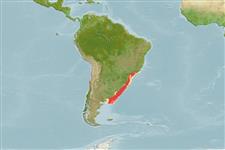Common names from other countries
Classification / Names / Names
Noms communs | Synonymes | Catalog of Fishes (gen., sp.) | ITIS | CoL | WoRMS
Environment: milieu / climate zone / depth range / distribution range
Écologie
; eau douce; profondeur 4 - 200 m (Ref. 83435). Tropical, preferred 18°C (Ref. 107945); 23°S - 42°S, 74°W - 42°W
Distribution
Pays | Zones FAO | Écosystèmes | Occurrences | Introductions
Southwest Atlantic and Southeast Pacific: From Rio de Janeiro, Brazil to San Matiás Gulf, Argentina. In the Pacific it is found in Chile. Tropical to subtropical.
Length at first maturity / Taille / Poids / Âge
Maturity: Lm ?, range 12 - 13 cm Max length : 27.0 cm DL mâle / non sexé; (Ref. 83435)
Minimum depth range from Ref. 122063. Lives in shallow waters at maximum depths of 4 m during low tide. Found on sandy subtrates with boulders and sponges. Individuals spend most of their time buried. Females attach their egg capsules to benthic hard substrata such as mollusk shells and/or pebbles (Ref. 122063). Voracious predator on bivalves (Ref. 114777).
Life cycle and mating behavior
Maturité | Reproduction | Frai | Œufs | Fécondité | Larves
This species is a non-broadcast spawner. Life cycle does not include trocophore stage. Also Ref. 833.
SAUP Database. 2006. (Ref. 356)
Statut dans la liste rouge de l'IUCN (Ref. 130435)
statut CITES (Ref. 108899)
Not Evaluated
Not Evaluated
Utilisations par l'homme
Pêcheries: commercial
FAO - pêcheries: landings | FishSource | Sea Around Us
Outils
Sources Internet
Estimates based on models
Preferred temperature
(Ref.
115969): 19.5 - 21.2, mean 20 (based on 9 cells).
Résilience
Milieu, temps minimum de doublement de population : 1,4 à 4,4 années (K=0.21; tm=8.5).
